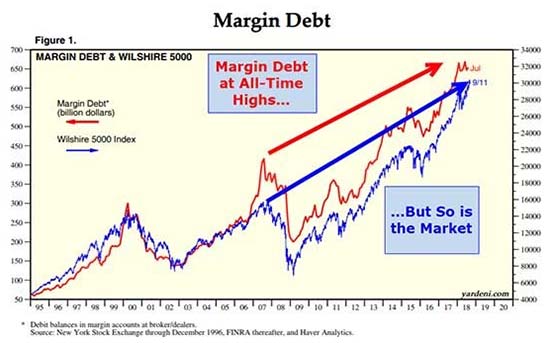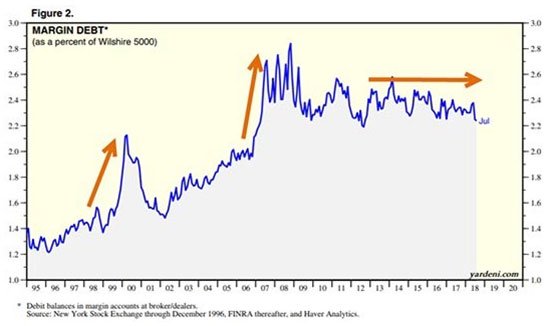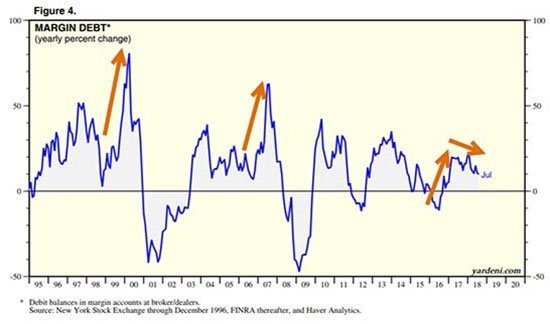No matter how bullish they may be, every investor must come to terms with the fact that this bull market, the longest in postwar history, is well over nine and a half years old now.
For that reason alone, it's important that we continue to look objectively at potential signals out there that might indicate the market becoming overextended to the upside.
Now, if you've been with us a while, it won't surprise you at all to learn that I look at thousands of charts each week. So, when a graphic hits my screen that I think is particularly useful, I like to pass it on.
I've found some charts that give us a top-down, "30,000-foot" view of the margin debt in play on the U.S. stock markets.
Margin debt is just money that is borrowed to buy stocks; most retail accounts can borrow 100% of their account balance to buy additional stock - at fairly low interest rates, too.
So why are we peeking at other people's money?
Well, analysts use margin debt as one measure of market participants' risk appetite. That "zest" for risk - or aversion to it, as the case may be - is a pretty good indicator of how much buying or selling you can reasonably expect in the short term.
Because it's important, margin levels are a never-ending grist for the article mill. In fact, you may have read some articles worrying about the fact that margin debt is at all-time absolute highs.
They're right about one thing: Margin is at all-time absolute highs, so let's dive in and look at what the charts have to show us...
[mmpazkzone name="in-story" network="9794" site="307044" id="137008" type="4"]
Margin Is High, but So Are Stock Prices
Ed Yardini of his own, eponymous research firm puts out consistently interesting looks at various aspects of the market.
Recently, Yardini looked at this very issue of margin debt, which many people would use as a proxy for the amount of leverage (and therefore additional risk) that traders and investors are taking on.
Billions Are Now in Play: Millions of Americans could collect "Federal Rent Checks" - to learn how to claim your portion of an $11.1 billion money pool using this backdoor investment, click here now...
Here's the first chart:

As we can see, margin debt is indeed higher in absolute terms than it was at the 2000 and 2007 market tops. But the total amount of money represented by stocks has been growing even faster, as we see in this chart:

This one's really telling. The chart shows us that the use of margin debt went up even faster than the market climbed in the runs up to the 2000 and 2007 tops. But during this current, 9-year, 6-month bull run, margin has merely kept pace with the market.
To put an even finer point on it, this last chart shows the year-over-year percent change for margin debt. Pay particular attention to the orange arrows:

We can see that the "enthusiastic" use of margin was greatest leading up to the Internet "dot-com" bubble in 2000. We see further that it was only a little less robust leading up the real estate and debt bubble in 2007. It's been significant, but quite muted in comparison to the other two bull runs over the last several years of this ongoing bull market.
So, what does this all tell us?
The bottom line from where I'm sitting is that margin is high, but that it looks like a pretty darn healthy expansion during a time of prolonged market growth.
Could it change and become unhealthy? Sure. But right now, on the hunt for technical bubble signals, this isn't a prime candidate today.
Four Cannabis Stocks Potentially Destined to Soar Up to 1,000% This Election Year
In the election year of 2012, marijuana stocks started rare gains of as much as 3,240%.
In 2014, they started producing up to 4,606% profits.
In 2016, they began rare climbs of 6,074% and more.
How much richer could select cannabis stocks make YOU in the election year of 2018? Take a look...
Follow Money Morning on Facebook, Twitter, and LinkedIn.
About the Author
D.R. Barton, Jr., Technical Trading Specialist for Money Map Press, is a world-renowned authority on technical trading with 25 years of experience. He spent the first part of his career as a chemical engineer with DuPont. During this time, he researched and developed the trading secrets that led to his first successful research service. Thanks to the wealth he was able to create for himself and his followers, D.R. retired early to pursue his passion for investing and showing fellow investors how to build toward financial freedom.



